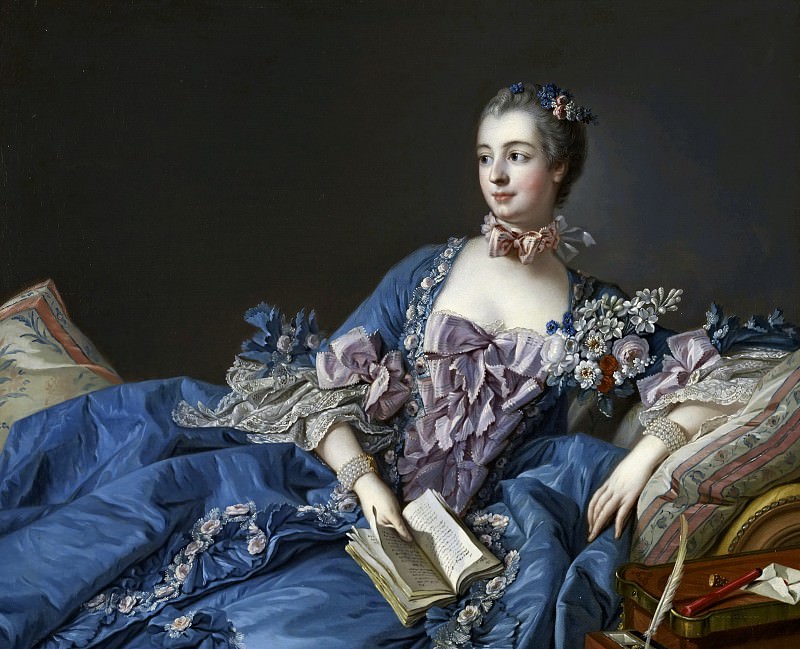Madame de Pompadour Francois Boucher (1703-1770)
Francois Boucher – Madame de Pompadour
Edit attribution
Download full size: 3987×3233 px (2,2 Mb)
Painter: Francois Boucher
François Boucher is a highly versatile French artist. His work is based on pictures with mythical and biblical subjects; he also liked to portray the daily activities of the inhabitants of Paris and pastoral scenes, and often took on portraits. The favorite of Louis fifteenth Marquise de Pompadour was his devoted admirer and friend; Boucher was engaged in the decoration of her residence and painted several formal portraits of the Marquise.
Description of the painting "Madame de Pompadour" by François Boucher
François Boucher is a highly versatile French artist. His work is based on pictures with mythical and biblical subjects; he also liked to portray the daily activities of the inhabitants of Paris and pastoral scenes, and often took on portraits. The favorite of Louis fifteenth Marquise de Pompadour was his devoted admirer and friend; Boucher was engaged in the decoration of her residence and painted several formal portraits of the Marquise. Pompadour’s real name was Jeanne Antoinette Poisson. For nearly twenty years, she had enormous influence both on the king and the decisions he made, as well as on the affairs of state and the life of the kingdom. The king gave Jeanne-Antoinette the Pompadour estate and granted her the title of Marquise, after which she received a formal divorce from her husband.
Painting was a special passion of this woman, she set the fashion for all of Europe, her name was used for hairstyles, interiors, and costumes. Her favorite style was rococo, and she patronized not only Boucher, but all the representatives of this direction. François Boucher always painted the Marquise in silver, blue and green-olive tones. Apparently, he did not strive for accurate portrait likeness - the portraits of other artists de Pompadour looks a little different, rougher and harsher. Boucher idealized and partly deified his patroness and friend, reproducing the fashionable standard of female beauty at the time - a porcelain doll face, huge almond-shaped eyes, a small nose and a small plump mouth, a capricious expression. Jeanne-Antoinette herself often noted that Boucher painted her "very beautiful, but not very similar. All depictions of the Marquise differ from other portraits of the author - they are characterized by some intimacy, chamberiness, partly sensuality. However, almost always he portrayed the favorite of the King in the same pose, often with a book in his hand, changing only the clothes. The faces on the portraits also barely differ - the feeling that for more than ten years, the woman did not age at all.
The most famous portrait of the Marquise de Pompadour - in a blue-green dress with a slight silver sheen, decorated with pale roses. The Marquise is half-lying on a striped couch, looking thoughtfully into the distance, with an open book in her right hand. There is no doubt that Jeanne Antoinette’s attire is the quintessential fashion of the time. Pink and silver lace, a bow around her neck of the same delicate material, a multiple string of white pearls on her wrist, and flowers in her neat hair. The Marquise looks a little pretentious - many in Paris laughed at her bourgeois way of dressing, but surprisingly, a few months passed and they copied her style again.
Boucher perfectly captures the sense of purity and freshness emanating from de Pompadour. It was the Marquise who introduced the notion of washing almost daily to France - until then, ladies would stifle unpleasant body odors by pouring on perfume from head to toe. The scent at balls was terrifying. The King’s mistress was fragrant with roses, differentiating herself from other women - and gradually the fashion for daily washing swept Paris away. On this canvas, the Marquise is portrayed as confident and calm, a little pensive and dreamy; despite some well-known flaws in realism, the artist has managed to capture the essence of her character. It is thanks to these traits of her nature that the Marquise actually ruled the country for two decades, giving the King the opportunity to entertain and celebrate endlessly.
Кому понравилось
Пожалуйста, подождите
На эту операцию может потребоваться несколько секунд.
Информация появится в новом окне,
если открытие новых окон не запрещено в настройках вашего браузера.
You need to login
Для работы с коллекциями – пожалуйста, войдите в аккаунт (open in new window).




















You cannot comment Why?
The subtexts within the painting speak to several aspects of Madame de Pompadours life and persona. Her lavish attire and the opulent setting are clear indicators of her status and influence as the official chief mistress of King Louis XV. The rich blue of her dress symbolizes royalty and nobility, while the abundance of flowers can be interpreted as emblems of beauty and femininity, but also of transience. The book she holds signifies her intelligence and cultural sophistication. She was known as a patron of arts and literature, and the painting aims to portray her not just as a beautiful woman, but as an educated and cultured individual. The intimate, reclining pose suggests a moment of private life, yet the grandeur of her dress and the overall composition maintain an air of formality and public image. The presence of writing materials further reinforces the idea of her intellectual engagement and her role as a facilitator of intellectual and artistic endeavors at the court. The painting, therefore, serves as a complex portrayal of power, beauty, intellect, and the carefully curated public image of a highly influential historical figure.